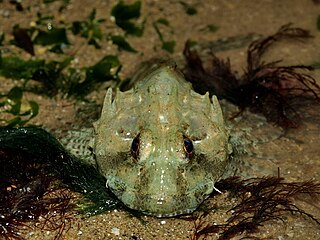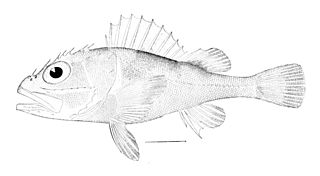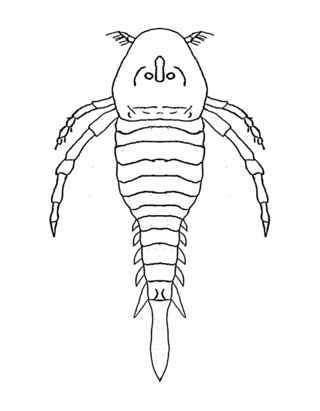See also
- Nepidae, an insect, commonly known as a water scorpion
Sea scorpion may refer to:

Scorpions are predatory arachnids of the order Scorpiones. They have eight legs, and are easily recognized by a pair of grasping pincers and a narrow, segmented tail, often carried in a characteristic forward curve over the back and always ending with a stinger. The evolutionary history of scorpions goes back 435 million years. They mainly live in deserts but have adapted to a wide range of environmental conditions, and can be found on all continents except Antarctica. There are over 2,500 described species, with 22 extant (living) families recognized to date. Their taxonomy is being revised to account for 21st-century genomic studies.

Sea urchins are spiny, globular echinoderms in the class Echinoidea. About 950 species of sea urchin are distributed on the seabeds of every ocean and inhabit every depth zone from the intertidal seashore down to 5,000 meters. The spherical, hard shells (tests) of sea urchins are round and covered in spines. Most urchin spines range in length from 3 to 10 cm, with outliers such as the black sea urchin possessing spines as long as 30 cm (12 in). Sea urchins move slowly, crawling with tube feet, and also propel themselves with their spines. Although algae are the primary diet, sea urchins also eat slow-moving (sessile) animals. Predators that eat sea urchins include a wide variety of fish, starfish, crabs, marine mammals, and humans.

Sand dollars are species of flat, burrowing sea urchins belonging to the order Clypeasteroida. Some species within the order, not quite as flat, are known as sea biscuits. Sand dollars can also be called "sand cakes" or "cake urchins".
A scorpion is a predatory arthropod animal.
Eleven ships of the Royal Navy have been named HMS Scorpion after the carnivorous arthropod, or the scorpion, a ballistic weapon in use in the Roman army:

Scorpaena is a widespread genus of marine ray-finned fish belonging to the family Scorpaenidae, the scorpionfishes.
In a zoological context, spines are hard, needle-like anatomical structures found in both vertebrate and invertebrate species. The spines of most spiny mammals are modified hairs, with a spongy center covered in a thick, hard layer of keratin and a sharp, sometimes barbed tip.
Diadema is the term for diadem in most Romance languages, and in English may refer to:

The long-spined bullhead, also known as the long-spined sea-scorpion, and the long-spined scorpion fish is a coastal fish of the sculpin family Cottidae, inhabiting marine waters of Europe.

Onychopterella is a genus of predatory eurypterid, an extinct group of aquatic arthropods. Fossils of Onychopterella have been discovered in deposits from the Late Ordovician to the Late Silurian. The genus contains three species: O. kokomoensis, the type species, from the Early Pridoli epoch of Indiana; O. pumilus, from the Early Llandovery epoch of Illinois, both from the United States; and O. augusti, from the Late Hirnantian to Early Rhuddanian stages of South Africa.

Megalograptidae are a family of eurypterids, an extinct group of chelicerate arthropods commonly known as "sea scorpions".

The Mixopteridae are a family of eurypterids, an extinct group of chelicerate arthropods commonly known as "sea scorpions". The family is one of two families contained in the superfamily Carcinosomatoidea, which in turn is one of the superfamilies classified as part of the suborder Eurypterina.

Stylonuridae is a family of eurypterids, an extinct group of chelicerate arthropods commonly known as "sea scorpions". The family is one of two families contained in the superfamily Stylonuroidea, which in turn is one of four superfamilies classified as part of the suborder Stylonurina.
C. bicolor may refer to:
Haemohormidium is a genus of parasitic alveolates in the phylum Apicomplexia. They have two hosts in their life cycle: the vertebrate hosts are fish and the invertebrate vectors are leeches.

Scorpaena scrofa, the red scorpionfish, bigscale scorpionfish, large-scaled scorpion fish, or rascasse is a venomous marine species of ray-finned fish in the family Scorpaenidae, the scorpionfishes. It is found in the Mediterranean Sea, in the eastern Atlantic Ocean and the western Indian Ocean.

Trachyscorpia is a genus of marine ray-finned fish belonging to the subfamily Sebastinae, the rockfishes, part of the family Scorpaenidae. The species in this genus are found in the Atlantic, Indian and Pacific oceans.

The Hardieopteridae are a family of eurypterids, an extinct group of chelicerate arthropods commonly known as "sea scorpions". The family is one of two families contained in the superfamily Kokomopteroidea, which in turn is one of four superfamilies classified as part of the suborder Stylonurina. Hardieopterids have been recovered from deposits of Early Silurian to Late Devonian age in the United States and the United Kingdom.

Parioscorpio is an extinct genus of arthropod containing the species P. venator known from the Silurian-aged Waukesha Biota of the Brandon Bridge Formation near Waukesha, Wisconsin. This animal has gone through a confusing taxonomic history, being called an arachnid, crustacean, and an artiopodan arthropod at various points. This animal is one of the more famous fossil finds from Wisconsin, due to the media coverage it received based on its original description in 2020 as a basal scorpion.